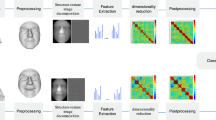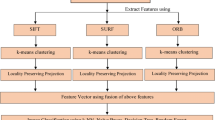Abstract
In this paper, we propose an enhanced Speeded Up Robust Features (eSURF) algorithm to save memory and increase the operating speed. From analysis and observation of the conventional SURF algorithm, we show that a large amount of memory is inefficiently used to detect interest points and considerable operations are repeatedly performed when generating the descriptors of interest points. In the proposed algorithm, the scale-space representation (SSR) step and location (LOC) step are unified based on an efficient memory allocation technique to remove unnecessary memory. In addition, operations for Haar wavelet responses (HWRs) in horizontal and vertical directions, which occupy a major portion of computational loads, are performed by using a fast computation technique in which redundant calculations and repeated memory accesses are efficiently eliminated. Simulation results demonstrate that the proposed eSURF algorithm achieves a time savings of approximately 30 % and a memory savings of approximately 35.7 %, while the feature extraction performance of the proposed eSURF algorithm is exactly identical to that of the conventional SURF algorithm.







Similar content being viewed by others
References
Bay, H., Ess, A., Tuytelaars, T., Gool, L.V.: Speeded-up robust features (SURF). Compt. Vis. Image Underst. 110(3), 346–359 (2008). doi:10.1016/j.cviu.2007.09.014
Lowe, D.G.: Distinctive image features from scale-invariant keypoints. Int. J. Comput. Vis. 60(2), 91–110 (2004)
Zhang, N.: Computing optimized parallel speed-up robust features on multi-core processors. Int. J. Parallel Prog. 38(2), 138–158 (2010). doi:10.1007/s10766-009-0122-9
Li, E., Yang, L., Wang, B., Li, J., Peng, P.: SURF cascade face detection acceleration on Sandy Bridge Processor. In: IEEE Computer Society Conference on Computer Vision and Pattern Recognition Workshops, pp. 41–47 (2012). doi:10.1109/CVPRW.2012.6238893
Hidalgo-Paniagua, A., Vega-Rodriguez, M.A., Pavon, N., Ferruz, J.: A comparative study of parallel software SURF implementations. Concur. Comput. Pract. Exp. 26, 2758–2771 (2014). doi:10.1002/cpe.3163
Kim, D., Kim, M., Kim, K., Sung, M., Ro, W.: Dynamic load balancing of parallel SURF with vertical partitioning. IEEE Trans. Parallel Distrib. Syst. (2014). doi:10.1109/TPDS.2014.2372763
Schaeferling, M., Kiefer, G.: Object recognition on a chip: a complete SURF-based system on a single FPGA. In: International Conference on Reconfigurable Computing and FPGAs, pp. 49–54 (2011)
Schaeferling, M., Hornung, U., Kiefer, G.: Object recognition and pose estimation on embedded hardware: SURF-based system designs accelerated by FPGA logic. Int. J. Reconfigurable Comput. (2012). doi:10.1155/2012
Fan, X., Wu, C., Cao, W., Zhou, X., Wang, S., Wang, L.: Implementation of high performance hardware architecture of OpenSURF algorithm on FPGA. In: International Conference on Field-Programmable Technology, pp. 152–159 (2013). doi:10.1109/FPT.2013.6718346
Lee, S.S., Jang, S.J., Kim, J., Hwang, Y., Choi, B.: Memory-efficient SURF architecture for ASIC implementation. Electron. Lett. 50(15), 1058–1059 (2014)
Han, B., Wang, Y., Jia, X.: Fast calculating feature point’s main orientation in SURF algorithm. In: International Conference on Computer, Mechatronics, Control and Electronic Engineering, pp. 165–168 (Aug. 2010). doi:10.1109/CMCE.2010.5609874
Evans, C.: Notes on the OpenSURF library. Technical Report, CSTR-09-001, University of Bristol, UK, 2009. http://www.chrisevansdev.com
Mikolajczyk, K., Schmid, C.: A performance evaluation of local descriptors. IEEE Trans. Pattern Anal. Mach. Intell. 27(10), 1615–1630 (2005)
Aly, M., Welinder, P., Munich, M., Perona, P.,: Towards automated large scale discovery of image families. In: IEEE Computer Society Conference on Computer Vision and Pattern Recognition Workshops, pp. 9–16 (2009). http://www.vision.caltech.edu/malaa/datasets/caltech-buildings/
Nister, D., Stewenius, H.,: Scalable recognition with a vocabulary tree. In: IEEE Computer Society Conference on Computer Vision and Pattern Recognition, 2, pp. 2161–2168 (2006). http://www.vis.uky.edu/∼stewe/ukbench/
Acknowledgments
This research was supported by Basic Science Research Program through the National Research Foundation of Korea (NRF) funded by the Ministry of Education (No. 2014R1A12056434).
Author information
Authors and Affiliations
Corresponding author
Rights and permissions
About this article
Cite this article
Cheon, S.H., Eom, I.K., Ha, S.W. et al. An enhanced SURF algorithm based on new interest point detection procedure and fast computation technique. J Real-Time Image Proc 16, 1177–1187 (2019). https://doi.org/10.1007/s11554-016-0614-y
Received:
Accepted:
Published:
Issue Date:
DOI: https://doi.org/10.1007/s11554-016-0614-y




